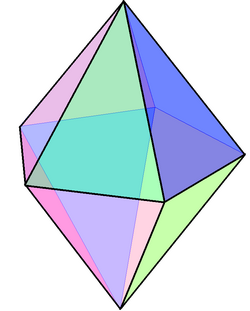Simplicial polytope
From HandWiki
Short description: Polytope whose facets are all simplices
In geometry, a simplicial polytope is a polytope whose facets are all simplices. For example, a simplicial polyhedron in three dimensions contains only triangular faces[1] and corresponds via Steinitz's theorem to a maximal planar graph.
They are topologically dual to simple polytopes. Polytopes which are both simple and simplicial are either simplices or two-dimensional polygons.
Examples
Simplicial polyhedra include:
- Bipyramids
- Gyroelongated dipyramids
- Deltahedra (equilateral triangles)
- Platonic
- Johnson solids:
- triangular bipyramid, pentagonal bipyramid, snub disphenoid, triaugmented triangular prism, gyroelongated square dipyramid
- Catalan solids:
Simplicial tilings:
- Regular:
- Laves tilings:
- tetrakis square tiling, triakis triangular tiling, kisrhombille tiling
Simplicial 4-polytopes include:
- convex regular 4-polytope
- Dual convex uniform honeycombs:
- Disphenoid tetrahedral honeycomb
- Dual of cantitruncated cubic honeycomb
- Dual of omnitruncated cubic honeycomb
- Dual of cantitruncated alternated cubic honeycomb
Simplicial higher polytope families:
- simplex
- cross-polytope (Orthoplex)
See also
Notes
- ↑ Polyhedra, Peter R. Cromwell, 1997. (p.341)
References
- Cromwell, Peter R. (1997). Polyhedra. Cambridge University Press. ISBN 0-521-66405-5. https://books.google.com/books?id=OJowej1QWpoC&q=Polyhedra&pg=PP1.
 |


